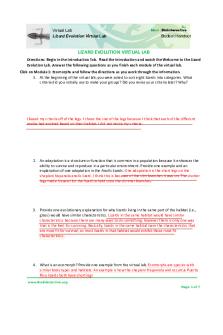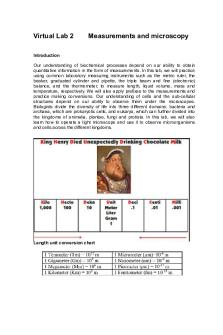Lizard Evolution Virtual Lab Student Worksheet 1-1 PDF

| Title | Lizard Evolution Virtual Lab Student Worksheet 1-1 |
|---|---|
| Author | Anna Wilburn |
| Course | business essential |
| Institution | Paine College |
| Pages | 7 |
| File Size | 318.3 KB |
| File Type | |
| Total Downloads | 61 |
| Total Views | 168 |
Summary
Work for biology- wouldnt let me hit biology, just business for some reason....
Description
Virtual Lab Lizard Evolution Virtual Lab
Student Handout
LIZARD EVOLUTION VIRTUAL LAB Directions: Begin in the Introduction Tab. Read the Introduction and watch the Welcome to the Lizard Evolution Lab. Answer the following questions as you finish each module of the virtual lab. Click on Module 1: Ecomorphs and follow the directions as you work through the information. 1. At the beginning of the virtual lab, you were asked to sort eight lizards into categories. What criteria did you initially use to make your groups? Did you revise your criteria later? Why?
I based my criteria off of the legs. I chose the size of the legs because I think that each of the different anoles had evolved based on their habitat. I did not revise my criteria.
2. An adaptation is a structure or function that is common in a population because it enhances the ability to survive and reproduce in a particular environment. Provide one example and an explanation of one adaptation in the Anolis lizards. One adaptation is the short legs on the sheplani hispanola anolis lizard. I think this is because of the slim branches it was on. The shorter legs made it easier for the lizard to hold onto the slimmer branches.
3. Provide one evolutionary explanation for why lizards living in the same part of the habitat (i.e., grass) would have similar characteristics. Lizards in the same habitat would have similar characteristics because there are many ways to do something, however there is only one way that is the best for surviving. Basically, lizards in the same habitat have the characteristics that are most fit for survival, so most lizards in that habitat would exhibit those most fit characteristics.
4. What is an ecomorph? Provide one example from the virtual lab. Ecomorphs are species with similar body types and habitats. An example is how the sheplani Hispaniola and occultus Puerto Rico lizards both have short legs www.BioInteractive.org Page 1 of 7
Virtual Lab Lizard Evolution Virtual Lab
Student Handout
5. How is an ecomorph different from a species? It only classifies the organism as having similar body types and habitats, but species can have other different characteristics such as color or look
6. Explain how a particular body feature of one of the lizard ecomorphs from the virtual lab is an adaptation to their particular niche. The occultus Puerto Rico anole has short legs because it needs to be able to stick to/crawl on slim twigs in their habitat.
February 2015
Module 2: Phylogeny 7. In module 1, you identified which species of lizards were most similar to one another based on relative limb length and toe pad size. In this module, you determined which lizards are more similar to one another based on what type of information? I determined which lizards are more similar based on DNA sequence analysis
8. Are the species of lizard that are more similar to one another according to body type also more closely related based on the results obtained in this module? Explain your answer. The species that are similar according to body type are not more closely related based on the results obtained from the DNA sequence analysis.
9. The figures below show two phylogenetic trees similar to the one you constructed in the virtual lab but with more lizards. The trees below show the evolutionary relationships among species from four ecomorphs from the four largest Caribbean islands.
www.BioInteractive.org Page 2 of 7
Student Handout
Figure 1. Phylogeny of anole lizards on four of the major Caribbean islands color-coded according to geographical distribution. Light dotted line, Puerto Rico; small dashed line, Cuba; large dashed line, Hispaniola; and solid line, Jamaica.
Figure 2. Phylogeny of anole lizards in the four major Caribbean islands colored in according to ecomorph. Light dotted line, twig; small dashed line, trunk-ground; large dashed line, trunk-crown; solid line, grassbus.
February 2015
10. What conclusion can you draw about the evolution of the Anolis lizards based on these figures? The evolution of the Anolis lizards is based on ecological niches on an island rather than the entire island itself.
www.BioInteractive.org Page 3 of 7
Virtual Lab Lizard Evolution Virtual Lab
Student Handout
11. What is convergent evolution? Use evidence from the trees to explain how the Anolis lizards are an example of this concept. Convergent evolution is where organisms that aren't closely related, independently evolve and have similar traits due to similar environments or ecological niches. The phylogenetic trees show this type of evolution because similar traits are based on environments, and not location/species type. An example would be anolis cybotes and anolis sagrei both are trunk ground anoles, but live on different islands.
Module 3: Experimental Data 12. In Dr. Losos’s experiment, why was it important that the experimental islands lacked lizards? It allowed each ecomorph to be isolated and easier to study their evolutions
13. Dr. Losos’s data suggest that after only a few generations, the lizards on the experimental islands have shorter legs on average than the lizards on the larger island. Explain how the data you collected either supports or does not support this claim. Because the environment on the island was more suited for shorter legs, the lizards evolved to have shorter legs. Ecomorphs are based on ancestral causes, not geological location/isolation, so the anoles evolved with shorter legs because shorter legs increased their chances of survival.
14. Based on what you know about the experimental islands and the lizards that were placed on these islands, explain how and why the average leg length of the population might change over time. Include the concept of natural selection in your discussion. The average leg length of the population will shrink because of the ecological niches of the experimental island. Because the advantage of longer legs has been lost, some of the anoles will evolve with shorter legs. The ones with shorter legs will survive better and the ones with longer legs will die off. Therefore, in the end anoles with shorter legs will dominate the population. This process is called natural selection.
15. If the population from one of the experimental islands were reintroduced on the original island, do you predict that lizards from the two populations would still mate and reproduce? Justify your answer with scientific arguments. Both short legged and long legged will still mate and reproduce www.BioInteractive.org Page 4 of 7
Virtual Lab Lizard Evolution Virtual Lab
Student Handout
because the lizards are still of the same species and because it will increase their species chances of survival.
February 2015
Module 4: Dewlap Colors 16. Anolis cristatellus and A. cooki are both trunk-ground anoles that live on Puerto Rico. A. cristatellus lives in a shady, forest environment, while A. cooki lives in an open, sunny environment. What is an adaptive explanation for why the dewlap of one species evolved to be brighter and that of another species darker? The A. cristatellus has a brighter dewlap and the A. cooki has a darker dewlap. Their dewlap contrasts the brightness of their environment, most likely because it stands out more and attracts more female anoles.
17. From the bar graph generated in the virtual lab (see below), how do the dewlap colors of the two species compare? The A. cristatellus has a brighter dewlap by +2.3 and the A. cooki has a darker dewlap by -2.3.
www.BioInteractive.org Page 5 of 7
Virtual Lab Lizard Evolution Virtual Lab
Student Handout
18. How would you determine whether the difference between the two populations is statistically significant? Their bars in the graph have different lengths.
19. If a species of anoles with dark dewlaps colonized a heavily forested island, predict what would happen over time to the color of the dewlap. Using your knowledge of natural selection and genetics, explain your prediction. The dewlaps would eventually begin to become lighter shades due to natural selection in finding a mate.
www.BioInteractive.org Page 6 of 7
Virtual Lab Lizard Evolution Virtual Lab
Student Handout
February 2015
www.BioInteractive.org Page 7 of 7...
Similar Free PDFs

Lizard Evolution Activities
- 3 Pages

Virtual Enzyme Lab Worksheet
- 4 Pages

Immunology Lab Worksheet Student
- 7 Pages

Lab 11 Respiration worksheet
- 5 Pages

bio 245 Lab 11 worksheet
- 2 Pages
Popular Institutions
- Tinajero National High School - Annex
- Politeknik Caltex Riau
- Yokohama City University
- SGT University
- University of Al-Qadisiyah
- Divine Word College of Vigan
- Techniek College Rotterdam
- Universidade de Santiago
- Universiti Teknologi MARA Cawangan Johor Kampus Pasir Gudang
- Poltekkes Kemenkes Yogyakarta
- Baguio City National High School
- Colegio san marcos
- preparatoria uno
- Centro de Bachillerato Tecnológico Industrial y de Servicios No. 107
- Dalian Maritime University
- Quang Trung Secondary School
- Colegio Tecnológico en Informática
- Corporación Regional de Educación Superior
- Grupo CEDVA
- Dar Al Uloom University
- Centro de Estudios Preuniversitarios de la Universidad Nacional de Ingeniería
- 上智大学
- Aakash International School, Nuna Majara
- San Felipe Neri Catholic School
- Kang Chiao International School - New Taipei City
- Misamis Occidental National High School
- Institución Educativa Escuela Normal Juan Ladrilleros
- Kolehiyo ng Pantukan
- Batanes State College
- Instituto Continental
- Sekolah Menengah Kejuruan Kesehatan Kaltara (Tarakan)
- Colegio de La Inmaculada Concepcion - Cebu










